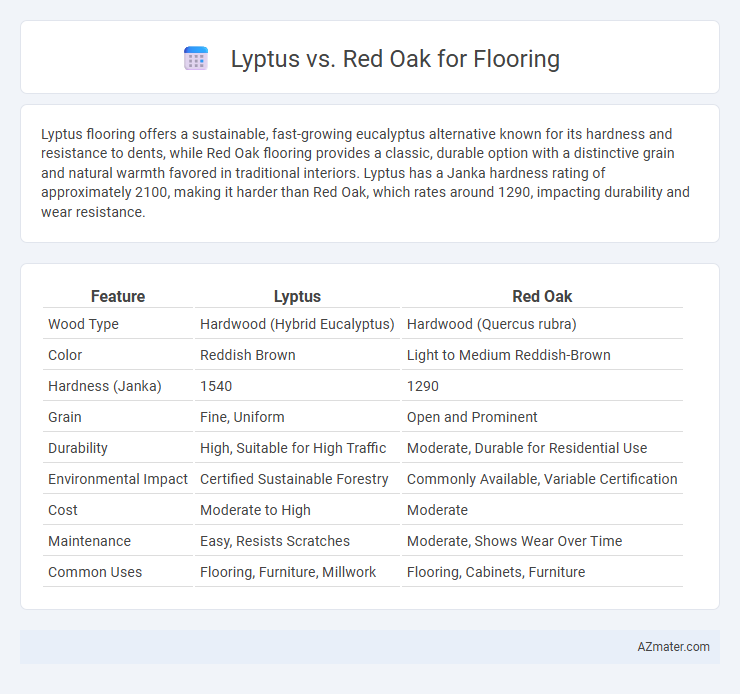Lyptus flooring offers a sustainable, fast-growing eucalyptus alternative known for its hardness and resistance to dents, while Red Oak flooring provides a classic, durable option with a distinctive grain and natural warmth favored in traditional interiors. Lyptus has a Janka hardness rating of approximately 2100, making it harder than Red Oak, which rates around 1290, impacting durability and wear resistance.
Table of Comparison
| Feature | Lyptus | Red Oak |
|---|---|---|
| Wood Type | Hardwood (Hybrid Eucalyptus) | Hardwood (Quercus rubra) |
| Color | Reddish Brown | Light to Medium Reddish-Brown |
| Hardness (Janka) | 1540 | 1290 |
| Grain | Fine, Uniform | Open and Prominent |
| Durability | High, Suitable for High Traffic | Moderate, Durable for Residential Use |
| Environmental Impact | Certified Sustainable Forestry | Commonly Available, Variable Certification |
| Cost | Moderate to High | Moderate |
| Maintenance | Easy, Resists Scratches | Moderate, Shows Wear Over Time |
| Common Uses | Flooring, Furniture, Millwork | Flooring, Cabinets, Furniture |
Introduction to Lyptus and Red Oak Flooring
Lyptus flooring, derived from a hybrid eucalyptus tree grown sustainably in South America, offers a durable and eco-friendly alternative to traditional hardwood options. Red Oak flooring, a classic choice in North American homes, is prized for its distinctive grain patterns and warm, reddish hues. Both Lyptus and Red Oak provide strong wear resistance, but Lyptus features a tighter grain and higher density, contributing to enhanced durability and a smoother finish.
Key Characteristics of Lyptus Wood
Lyptus wood, derived from a hybrid of Eucalyptus species, is known for its exceptional hardness, measuring 1500 on the Janka hardness scale, making it more durable than traditional Red Oak, rated at 1290. Its consistent grain pattern offers a smooth, uniform appearance, while its reddish-brown color closely resembles Red Oak but resists fading better over time. Sustainable harvesting practices and faster growth cycles make Lyptus an eco-friendly flooring option with high resistance to wear and dents.
Key Characteristics of Red Oak Wood
Red Oak wood features a distinct grain pattern with prominent open pores and a warm reddish hue, making it a popular choice for flooring due to its natural beauty. It offers excellent hardness, rated around 1290 on the Janka scale, ensuring durability and resistance to wear in high-traffic areas. Red Oak's abundance in North America makes it more affordable and readily available compared to exotic woods like Lyptus, which appeals to budget-conscious homeowners.
Durability and Hardness Comparison
Lyptus flooring offers a Janka hardness rating of approximately 2,300, making it harder and more resistant to dents compared to Red Oak, which has a Janka rating of about 1,290. This higher hardness level means Lyptus is better suited for high-traffic areas and environments prone to heavy wear. Red Oak, while durable and widely used, tends to scratch and dent more easily under similar conditions.
Appearance and Grain Patterns
Lyptus flooring features a consistent, medium reddish-brown hue with a fine, uniform grain, offering a sleek and modern look ideal for contemporary interiors. Red Oak displays a more varied color palette from light beige to rich reddish tones, with prominent, open grain patterns that create a classic, textured appearance. The uniformity of Lyptus contrasts with Red Oak's natural character, catering to different aesthetic preferences in flooring design.
Sustainability and Environmental Impact
Lyptus flooring, sourced from fast-growing, sustainably managed eucalyptus plantations, offers a lower environmental impact compared to Red Oak, which is harvested from slower-growing hardwood forests. Lyptus trees require less water and fewer pesticides, promoting faster reforestation and reduced deforestation pressures. Red Oak, though durable, often involves longer growth cycles and can contribute to habitat loss without responsible forestry certifications such as FSC.
Installation and Workability
Lyptus offers a smoother surface and uniform grain, making it easier to sand, cut, and install with precision, reducing labor time. Red Oak's open grain requires more effort during sanding and finishing but is widely preferred for its flexibility in handling nails and adhesives. Both woods are durable, but Lyptus's density demands sharper tools for clean cuts, while Red Oak provides easier workability for DIY flooring projects.
Maintenance and Long-Term Care
Lyptus flooring offers a smooth surface that resists moisture and stains, requiring minimal maintenance such as regular sweeping and occasional damp mopping. Red Oak demands consistent upkeep due to its open grain structure, including periodic refinishing and protection from scratches to preserve its appearance over time. Both materials benefit from using protective pads on furniture and avoiding excessive water exposure to extend their lifespan and maintain durability.
Cost and Value Considerations
Lyptus flooring offers a more cost-effective option compared to Red Oak, with prices typically 20-30% lower due to its faster growth rate and sustainable harvesting. Red Oak provides higher long-term value through its well-known durability and timeless aesthetic, often increasing home resale value. Choosing Lyptus balances initial affordability with eco-friendly benefits, while Red Oak emphasizes traditional appeal and investment longevity.
Choosing Between Lyptus and Red Oak for Your Floors
Choosing between Lyptus and Red Oak for flooring depends on durability, appearance, and environmental impact. Lyptus, a fast-growing hybrid eucalyptus, offers a hard, dense surface with a consistent grain and reddish hue ideal for high-traffic areas, while Red Oak provides classic warmth, pronounced grain patterns, and a well-known reputation for resilience and ease of refinishing. Consider Lyptus for sustainable flooring options certified by the Forest Stewardship Council (FSC) or opt for Red Oak when seeking traditional American hardwood with versatile stain compatibility.

Infographic: Lyptus vs Red Oak for Flooring
 azmater.com
azmater.com